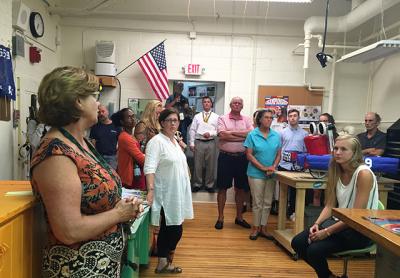School Expansion Long Overdue

Claudia Patterson often could be found last year sitting at a desk in the second-floor corridor of the Bridgehampton School, where an employee would normally be supervising the hallway. But Claudia is not a hall monitor. She was a sophomore, taking an online class that required independent study, and she had no other place to go. Every classroom was occupied every period of the day, even the computer lab, library, and cafeteria.
“There’s no real area to sit and do work, whether you’re ahead or behind,” she said during a tour of the school on Sept. 14 by about 25 residents who attended a public forum at which the district asked students, teachers, and school board members to make the case for expansion.
Signs of age and corrosion are evident in the ancient-looking safety station in the school’s sole science lab, which houses classes in the four high school disciplines: physics, earth science, biology, and chemistry. The robotics and computer lab in the basement is not accessible for the handicapped, and the emergency exit is up a ladder and through a window that is partially blocked by pipes.
Students study and do research in the library, but they also take classes in art and sewing there. Furthermore, because the second-floor classrooms were divided in half at some point in the past, most have a capacity for only 12 to 16 high school students while 18 or more are in the elementary grades now and expected to move up.
The gymnasium doubles as an auditorium, with a stage that is used as a fitness room and weight-lifting equipment that gets moved, often to a spot that blocks an exit, each time the drama club puts on a production. Dozens of rusty lockers, mostly from the original construction, are still used, and many are broken.
The gym itself, which accommodates physical education classes as well as recess, assemblies, and other functions, is much smaller than a regulation-size high school gym. The championship Killer Bees varsity is allowed to play there because the school was grandfathered in when regulations changed. Some schools refuse to play there, according to Bridgehampton officials.
“We’re not looking to modernize and expand the facilities in the hope that children will come,” Jeff Mansfield, a school board member, said at the forum. “We need to modernize and expand the facilities because they are already here.”
The Bridgehampton School, constructed in 1939, is the only local school to have never undergone a major building expansion. It has instead used a handful of portable buildings, which were added more than 40 years ago.
The Wainscott School opened its current building in 2007. The Amagansett School was expanded in 2000. The Montauk School, first built in 1927, saw additions in 1955, 1965, 1973, and 2000. The Springs School finished a new wing in 2002, and the East Hampton School District undertook a $79.2 million overhaul in 2006, with expansions to John M. Marshall Elementary School and East Hampton High School. Sag Harbor is in the midst of a $9.04 million capital project even though it has completed multiple additions and renovation at both of its buildings over the years. And the Sagaponack School, erected in 1885, was enlarged in 1920.
“We’re over a week into the school year,” Lois Favre, the district superintendent, said, “and today, we had to make a decision to move a classroom into the district office because we are running out of space. . . . It’s very disruptive to the educational process.”
Preliminary expansion plans include a 35,440-square-foot addition and renovations estimated at between $25 million and $30 million. Robert Hauser, the assistant superintendent for finance and facilities, said that for a project of $25 million with an estimated interest rate of 2 percent, the district’s debt would increase annual school taxes by about $135 for a house valued at $750,000. The district is already in the midst of paying off a 10-year, $1,350,000 bond for a window replacement project it undertook in 2011.
John Grillo, the district’s architect, said the drawings that have been drafted show a building that could accommodate 400 to 450 students. “At the end of this plan, there will be no more students in the basement,” he said.
Questions have been raised over whether the district will eventually need as much capacity as planned, however. A demographic study completed in May of 2015 by the Western Suffolk Board of Cooperative Educational Services projected 197 students by the year 2023 and said it then would begin to steady. But when school opened this year, enrollment was already at 209. The student population is up 35 percent from three years ago.
“We’re getting an influx of students at an even quicker rate than the demographic study is predicting,” Dr. Favre said.
With a date for a referendum estimated to take place by the end of 2016, several months for planning, design, and feedback, and about 16 weeks for approval by the New York State Education Department, school officials predict the district could break ground in the summer of 2018 and then spend 16 to 18 months on construction.
The conversation over space needs has been going on for at least as far back as 2005, but efforts to move forward with expansion have stalled several times.
